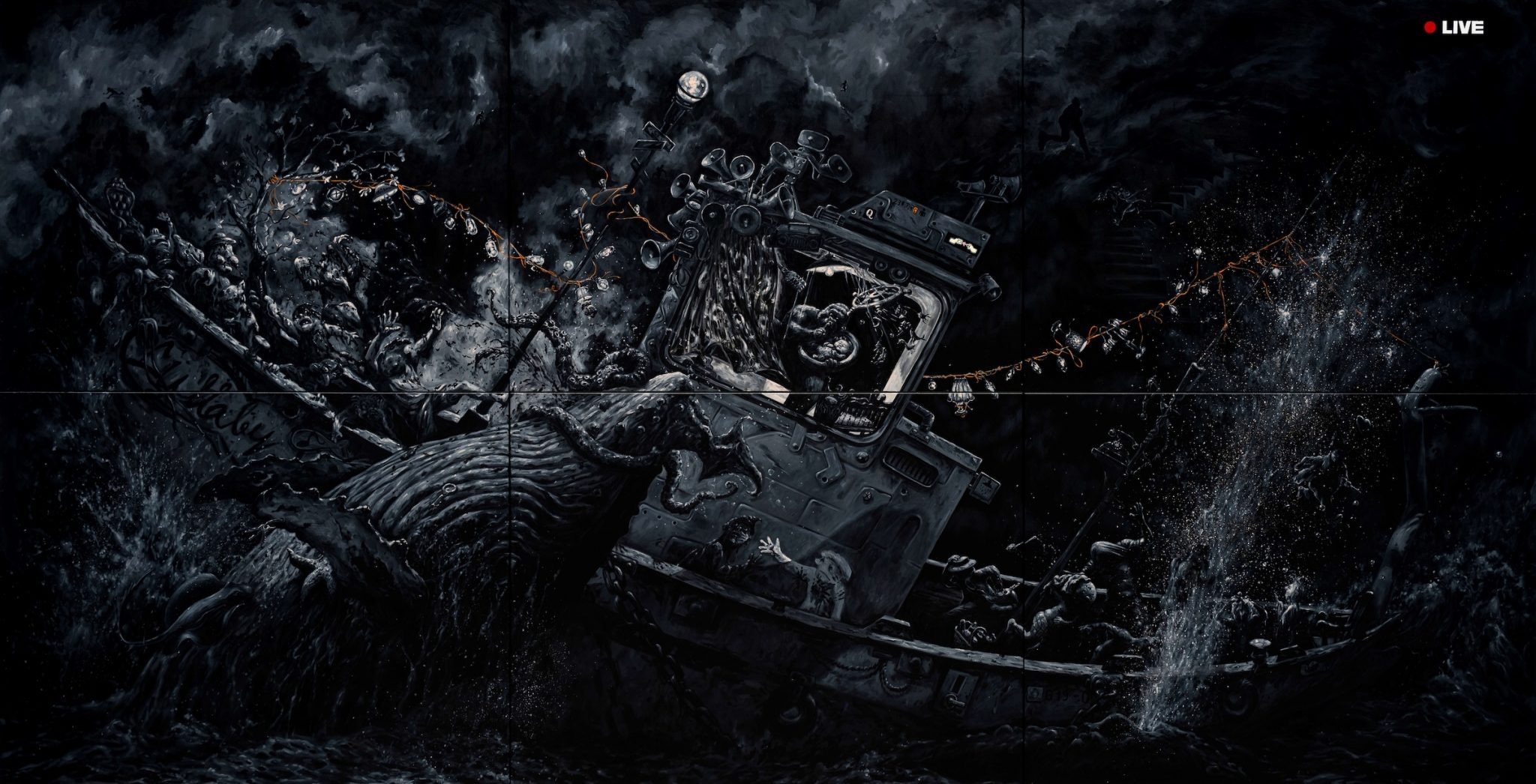Bae’s work leaves a trail of fine- and popular-art influences that might in turn speak to the shape of the general aesthetic of our times
If you’re wondering about what you’re about to dive into (as the title of this exhibition suggests you should be), Bae Yoon Hwan’s largescale figurative paintings provide a quick and obvious answer: the land (mining scenes) and the sea (fishing scenes). And a little art history for good measure (more on that later). Needless to say, the overall vibe is extractive. We’re Good (2025), for example, is a ten-metre black-and-(yellowish-)white oilstick painting that offers a claustrophobic tangle of gurning miners covering the entire canvas from edge to edge. The whole is punctured by tunnels, constellations of pit props and minecarts groaning with ore that collectively become like the holes in some sort of Swiss cheese.
The bulk of this show is formed of a series of similarly narrative comic strip grotesqueries painted on black backgrounds such that their characters and contexts emerge as a series of luminous highlights amid the darkness. Like the Milky Way, or a cluster of stars. Indeed, many of the works appear like etchings, as if the shapes and lines were bitten out of the surface in the same way as acid carves out a printing plate. You get a sense of form being fought for against a background that constantly threatens to swallow it up. Of people on the verge of an existential crisis.
Cradle (2025) features a humpback whale rising, threateningly, out of the sea and into a fishing vessel. It is hung against a black wall onto which the action in the painting seems to have escaped in the form of an explosion of loose, cursive, expressionist, graffiti-type lines that might represent the foaming sea or, given that the whites that surround the bottom of the painting turn to orange and red at the top, some sort of flaming pyre. It’s an appropriate metaphor, both for the ecological damage that is a consequence of the human activities being described and for the general harvesting of the earth.

What Bae offers is a collection of working-class scenes presented in a style that, in our urbanised, postindustrial present, we’d normally associate with remote eras. And his subjects, deep-sea fishing and deep mining, are activities that occur in geographically remote locations. Or on the Discovery Channel. Similarly remote are the aesthetic connections that Bae triggers: William Hogarth’s ‘modern moral subjects’ meeting Kuniyoshi’s ukiyo-e prints, combined with hints of Francisco Goya’s Los Caprichos (1797–98). But the paintings on show here are not so easily reduced to any of these art-historical precedents. Although other works explicitly nod to British painter Francis Bacon and French collagist Henri Matisse. Perhaps what’s more to the point is the way that Bae’s work leaves a trail of fine- and popular-art influences that might in turn speak to the shape of the general aesthetic of our times.
Indeed, there’s a deeper dive into this in the form of a sculpture comprising a series of objects piled up on or emerging from a tottering hill of wooden crates. Among the former are plush toys, papier-mâché figures, cartoons and children’s anatomical models, a cacophony of animate tree trunks, toy astronauts and anthropomorphised animal characters, some of whom might, by turns, be extras from a Studio Ghibli or Pixar movie. On the one hand it serves as a reminder that everything in the world around us tells a story; on the other that everything around us can be exploited and branded by humans. All of that buried, however, beneath a veneer of innocent, childish fun.
In that vein, Untitled (2025) features a shadowy mix of miners and sailors rowing a giant coracle through some unknown sea. Each of their heads supports an oversize tangerine segment, rendered in a luminous orange and standing in at some times for a hat, at others for a mohawk or similar hair-styling. The tangerine, for those in the know, is a celebrated fruit of Jeju Island, where Bae lives and works, surrounded too by waters famous for squid (particularly hanchi), which is the catch that the night fishermen in works such as Oasis–365 3 (2025) are going after. At the centre of the boat in Untitled is a museum display case housing a miner’s helmet. As if that activity really were a thing of the past. Although you can’t help thinking that imagining such a scenario might be just as ridiculous as wearing a tangerine segment as a hat.
Deep Diver at Space K, Seoul, through 9 November
From the November 2025 issue of ArtReview – get your copy.
